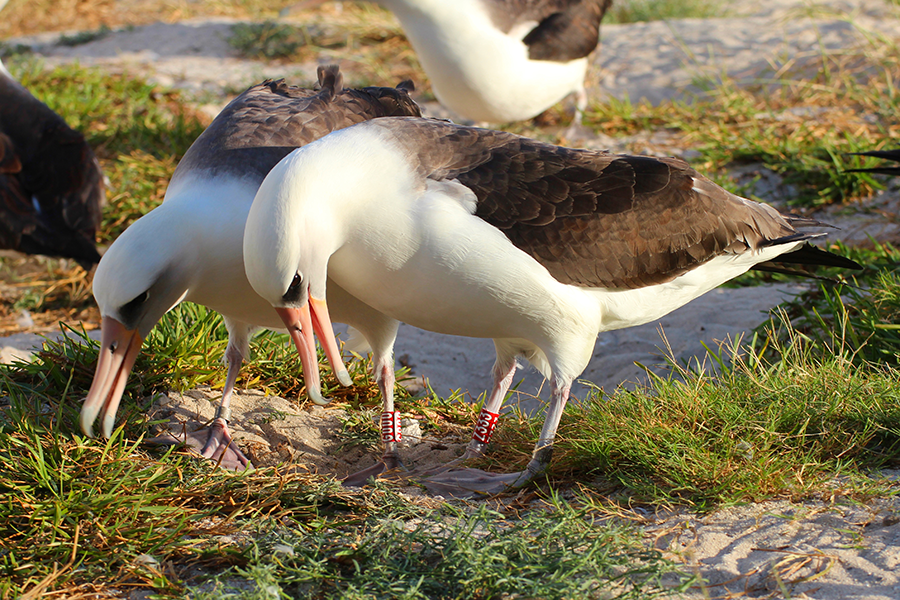World's oldest wild bird, an albatross, just hatched 40th chick – at age 65
Loading...
A Laysan albatross named Wisdom has hatched what could be her 40th chick, according to the US Fish and Wildlife Service, an impressive feat at her ripe age of at least 65.
Baby Kūkini, which is Hawaiian for “messenger,” was spotted cracking out of its shell on February 1 while under the care of its father, known simply as “Gooo,” a name that reflects the number 6,000 on the identification band around his leg. Gooo served on incubation duty for more than two weeks while waiting for Wisdom to return from gathering squid, small fish, and fish eggs to regurgitate to Kūkini.
“As soon as Kūkini was secure under Wisdom, Wisdom’s mate (shown here helping Kūkini hatch) quickly marched the length of a football field towards a path through the dunes and took flight. We expect him to be back within a week or less because newly hatched albatross chicks require a consistent supply of fresh seafood,” wrote staff from the United State’s largest conservation area, Papahānaumokuākea Marine National Monument in Honolulu, on Facebook on February 8. The area includes the Midway Atoll Refuge which houses the world’s largest albatross nesting colony, including Wisdom and her family.
Wisdom is the world's oldest known banded wild bird, and one of a million albatrosses nesting and raising their families at Midway. Albatrosses live from 40 to 60 years and can breed annually with their monogamous, lifelong partners, which are only replaced after death or disappearance.
The seabirds meet their partners at the same location each year to build a new nest together. For the Laysan albatrosses, the breeding happens primarily on the Hawaiian Islands between November and July. For the rest of the year, the birds stay in the northwestern and northeastern range of the Pacific Ocean, where they feed on sea creatures plucked from the surface of the water.
The aeronautical masters can soar for hours or even days without flapping their wings, and touch land only during breeding season, though they do rest on the water to feed and sleep. They can fly in their sleep to avoid predators such as whales and sharks.
Wisdom was first discovered by biologist Chandler Robbins, who is now 97 years old. He banded her when she first started breeding on Midway Atoll in 1956. He discovered her again, near the same location, 46 years later. When Dr. Robbins banded Wisdom more than half a century ago, he estimated that she was at least 5 years old, the youngest age at which an albatross can breed. This means that she could be much older than 65 today, notes the US Fish and Wildlife Service.
Throughout her long life, Wisdom has raised as many as 40 chicks, at least eight of them since 2006, say Papahānaumokuākea officials. Hawaiian conservationists estimate that she has flown more than three million miles since she was first tagged – the equivalent of six trips from the Earth to the Moon and back.
“Wisdom is an iconic symbol of inspiration and hope,” Robert Peyton, Midway refuge manager, said in an announcement.
“From a scientific perspective, albatrosses are a critical indicator species for the world’s oceans that sustain millions of human beings as well,” he said.
The birds face constant threats, including choking on ocean debris, getting scooped up as bycatch in fishing nets, losing breeding areas to environmental degradation, and being crowded out by invasive species. They were slaughtered in great numbers in the 19th century, when they were coveted for their valuable feathers, sold in Europe for use on women’s hats, and for the albumen from their eggs, which was used to develop film.
According to federal conservationists, a 19th-century report from a Smithsonian expedition to Hawaii first brought attention to the birds' plight, inspiring president Theodore Roosevelt in 1909 to designate the northwestern Hawaiian Islands as one of the first federally protected seabird reserves in the country.






